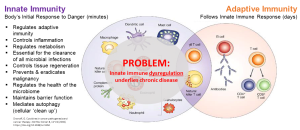Understanding Innate and Adaptive Immunity: A Comprehensive Guide
Understanding Innate Immunity
Innate immunity serves as the body’s initial defense against pathogens, offering rapid but non-specific responses to a wide range of invaders. It’s a crucial component of the immune system, encompassing physical barriers, chemical defenses, and various immune cells.
Physical Barriers
The skin and mucous membranes act as the body’s primary physical barriers against pathogens. The skin forms a tough, impermeable barrier, while mucous membranes line the respiratory, digestive, and other tracts, producing mucus that traps pathogens.
Chemical Defenses
Several chemical factors contribute to protection against pathogens. These include enzymes in tears and saliva that break down bacterial cell walls, stomach acid that kills many ingested pathogens, and antimicrobial peptides produced by various cells to inhibit microbial growth.
Cellular Components
Phagocytes
Phagocytes are cells that engulf and digest pathogens and debris. Neutrophils, the most abundant type, are quickly recruited to infection sites. Macrophages are long-lived and can engulf larger particles. Dendritic cells capture antigens and present them to activate other immune cells.
Natural Killer (NK) Cells
NK cells are specialized lymphocytes that recognize and destroy virus-infected cells and cancer cells. They release chemicals that lead to cell death, without needing prior exposure to the specific pathogen.
Mast Cells
Found in tissues, mast cells play a role in inflammation and allergic responses. They release histamine and other chemicals in response to pathogens, triggering immune responses.
Basophils and Eosinophils
These cells are involved in allergic responses and defense against parasites.
Inflammatory Response
When tissues are injured or infected, the body triggers an inflammatory response. This involves the release of cytokines and other signaling molecules that increase blood flow to the area, making it red and warm. This helps deliver immune cells to the site and increases the permeability of blood vessels, allowing immune cells to move from the bloodstream to the site of infection.
Complement System
This is a group of proteins that circulate in the blood and are activated in response to pathogens. They can directly destroy pathogens, attract phagocytes, and enhance the effectiveness of antibodies.
Cytokines
Cytokines are signaling molecules that regulate immune responses. They can stimulate inflammation, activate immune cells, and regulate the growth and activity of immune cells.
Pattern Recognition Receptors (PRRs)
These receptors are found on immune cells and recognize specific patterns on pathogens, such as bacterial cell walls or viral RNA. When PRRs bind to these patterns, they trigger immune responses.
Innate immunity is critical for early defense against pathogens and plays a role in shaping the adaptive immune response by activating and modulating specific immune cells. 

Exploring Primary Lymphoid Organs
Primary lymphoid organs are a key part of the immune system where lymphocytes, a type of white blood cell, are produced and mature. These organs include the bone marrow and the thymus gland.
Bone Marrow
This spongy tissue is found inside bones, particularly in the flat bones like the hip bones, breastbone, skull, and spine. Bone marrow is responsible for producing all types of blood cells, including red blood cells (which carry oxygen), white blood cells (which fight infection), and platelets (which help blood clot). In the context of the immune system, it is the site where B lymphocytes (B cells) develop and mature. B cells play a crucial role in the humoral immune response, producing antibodies that recognize and neutralize pathogens.
Thymus
The thymus is located in the upper chest behind the breastbone. It is most active during infancy and childhood, gradually decreasing in size and activity as we age. The thymus is where T lymphocytes (T cells) mature. T cells are important for cell-mediated immunity, where they directly attack infected or abnormal cells. The thymus provides a unique environment for T cells to mature and develop their specific receptors without attacking the body’s own cells.
In summary, primary lymphoid organs are essential for the development and maturation of lymphocytes, which are crucial for the body’s immune response. Without these organs, the immune system would not be able to effectively recognize and combat pathogens.
